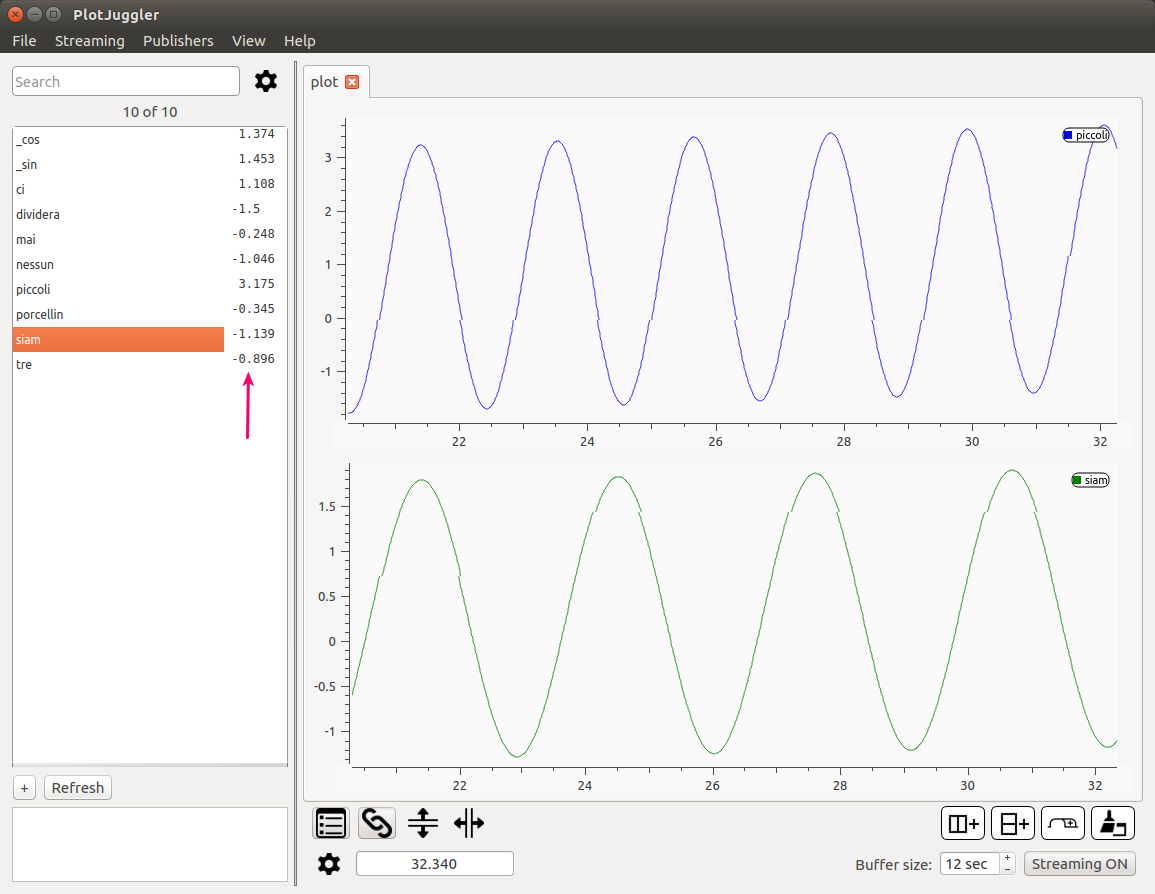One very quick and dirty method is to use rviz as an oscilloscope, and have a node that converts the array message to a Marker with a LINE_STRIP in it. https://github.com/lucasw/sdl2_ros/bl... does this for the Int16MultiArray message (it doesn't do anything with the multi array variables, just plots the data).
self.pub = rospy.Publisher("marker", Marker, queue_size=2)
marker = Marker()
marker.header.frame_id = rospy.get_param("~frame_id", "map")
marker.ns = "plot" # marker.header.frame_id
marker.id = 0
marker.type = Marker.LINE_STRIP
marker.action = Marker.ADD
marker.pose.orientation.w = 1.0
# should be smaller then index_scale if individual points can vary a lot
scale = rospy.get_param("~line_thickness", 0.01)
marker.scale.x = scale
marker.scale.y = scale
marker.scale.z = scale
marker.color.a = 1.0
marker.color.r = rospy.get_param("~r", 1.0)
marker.color.g = rospy.get_param("~g", 1.0)
marker.color.b = rospy.get_param("~b", 1.0)
self.marker = marker
self.max_points = rospy.get_param("~max_points", 1000)
self.step = rospy.get_param("~step", 1)
self.index_scale = rospy.get_param("~index_scale", 0.001)
self.y_scale = rospy.get_param("~y_scale", 1.0 / (2**15))
self.sub = rospy.Subscriber("audio", Int16MultiArray,
self.callback, queue_size=1)
def callback(self, msg):
self.marker.points = []
for i in range(0, len(msg.data), self.step):
if (i > self.max_points):
break
pt = Point()
pt.x = i * self.index_scale
pt.y = msg.data[i] * self.y_scale
pt.z = 0
self.marker.points.append(pt)
This method isn't efficient for thousands and thousands of points, though, and the line thickness needs to be manipulated depending on the data (being able to set Marker line width in distance independent pixels would help).
I might clean this up, generalize it, and maybe make it a standalone package.
Another very quick and more efficient method is to plot the data into an Image and publish it: https://github.com/lucasw/audio_commo... (uses ChannelFloat32)
def __init__(self):
self.bridge = CvBridge()
self.fade1 = rospy.get_param("~fade1", 0.9)
self.fade2 = rospy.get_param("~fade2", 0.99)
self.buffer = collections.deque(maxlen=8192)
self.im = np.zeros((256, 1300, 3), np.uint8)
self.pub = rospy.Publisher("image", Image, queue_size=1)
self.sub = rospy.Subscriber("decoded", ChannelFloat32,
self.audio_callback, queue_size=1)
self.timer = rospy.Timer(rospy.Duration(0.05), self.update)
def audio_callback(self, msg):
for i in range(len(msg.values)):
self.buffer.append(msg.values[i])
def update(self, event):
self.im[:, :, 1:3] = (self.im[:, :, 1:3] * self.fade1).astype(np.uint8)
self.im[:, :, 0] = (self.im[:, :, 0] * self.fade2).astype(np.uint8)
width = self.im.shape[1]
height = self.im.shape[0]
last_y = 0
for i in range(0, width):
if i >= len(self.buffer):
break
sample = self.buffer[i]
sample *= height/2
sample += height/2
y = int(sample) % height
y0 = min(last_y, y)
y1 = max(last_y, y)
self.im[y0:y1+1, i, :] = 255
last_y = y
self.pub.publish(self.bridge.cv2_to_imgmsg(self.im, "bgr8"))
Maybe plotjuggler, rqt_plot, or the new graph_rviz_plugin https://gitlab.com/InstitutMaupertuis... can ... (more)



